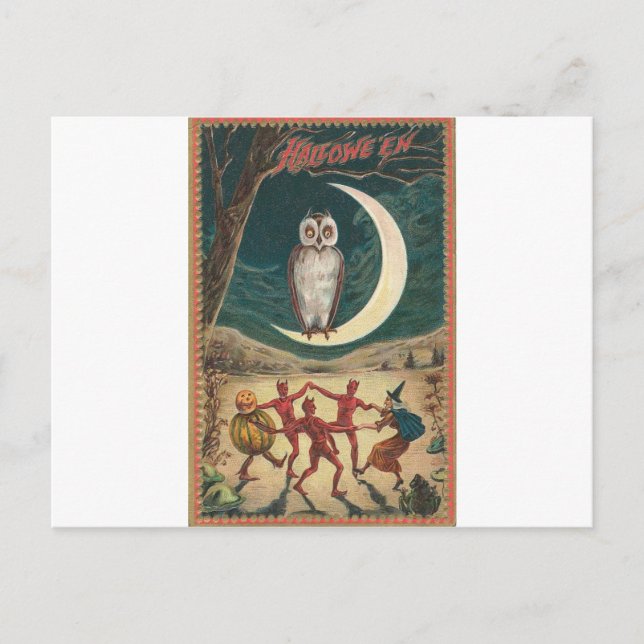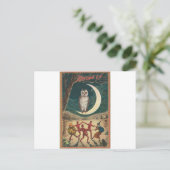Shop Our Top Picks
Shop by Category
Accessories
Baby & Kids
Clothing & Shoes
Crafts & Party Supplies
Electronics
Home Décor
Invitations & Stationery
Office & School
Sports, Toys & Games
Wall Art & Décor
Weddings
Create Your Own
Officially Licensed Brands
Find the Perfect Gift
Zazzle Ideas
More Ways to Save

by .
Vintage Halloween Greeting Cards Classic Posters
$1.65 Comp. value
i
$1.41
per postcard
Save 15% with code FRESHFINDS4U
View Product DetailsAbout Postcards
Sold by
Maker
About This Design
Vintage Halloween Greeting Cards Classic Posters
It has roots in the Celtic festival of Samhain and the Christian holy day of All Saints’ Day. It is largely a secular celebration, but some Christians and pagans have expressed strong feelings about its religious overtones. Irish immigrants carried versions of the tradition to North America during Ireland's Great Famine of 1846. The day is often associated with the colors orange and black, and is strongly associated with symbols such as the jack-o'-lantern. Halloween activities include trick-or-treating, wearing costumes, ghost tours, bonfires, costume parties, visiting haunted attractions, carving jack-o'-lanterns, reading scary stories, and watching horror movies. Halloween has origins in the ancient Celtic festival known as Samhain Irish pronunciation; from the Old Irish samain, possibly derived from Gaulish samonios). The festival of Samhain is a celebration of the end of the harvest season in Gaelic culture, and is sometimes regarded as the "Celtic New Year". Traditionally, the festival was a time used by the ancient Celtic pagans to take stock of supplies and slaughter livestock for winter stores. The ancient Celts believed that on October 31, now known as Halloween, the boundary between the living and the deceased dissolved, and the dead become dangerous for the living by causing problems such as sickness or damaged crops. The festivals would frequently involve bonfires, into which the bones of slaughtered livestock were thrown. Costumes and masks being worn at Halloween goes back to the Celtic traditions of attempting to copy the evil spirits or placate them, in Scotland for instance where the dead were impersonated by young men with masked, veiled or blackened faces, dressed in white. The term Halloween, originally spelled Hallowe’en, is shortened from All Hallows’ Even (both even and eve are abbreviations of evening, but Halloween gets its n from even) as it is the eve of "All Hallows’ Day", which is now also known as All Saints’ Day. It was a day of religious festivities in various northern European pagan traditions,[11] until Popes Gregory III and Gregory IV moved the old Christian feast of All Saints’ Day from May 13 (which had itself been the date of a pagan holiday, the Feast of the Lemures) to November 1. In the 9th century, the Church measured the day as starting at sunset, in accordance with the Florentine calendar. Although All Saints’ Day is now considered to occur one day after Halloween, the two holidays were, at that time, celebrated on the same day. On Hallows’ eve, the ancient Celts would place a skeleton on their window sill to represent the departed. Originating in Europe, these lanterns were first carved from a turnip or rutabaga. Believing that the head was the most powerful part of the body, containing the spirit and the knowledge, the Celts used the "head" of the vegetable to frighten off the embodiment of superstitions. Welsh, Irish and British myth are full of legends of the Brazen Head, which may be a folk memory of the widespread ancient Celtic practice of headhunting - the results of which were often nailed to a door lintel or brought to the fireside to speak their wisdom. The name jack-o'-lantern can be traced back to the Irish legend of Stingy Jack, a greedy, gambling, hard-drinking old farmer. He tricked the devil into climbing a tree and trapped him by carving a cross into the tree trunk. In revenge, the devil placed a curse on Jack, condemning him to forever wander the earth at night with the only light he had: a candle inside of a hollowed turnip. The carving of pumpkins is associated with Halloween in North America where pumpkins are both readily available and much larger- making them easier to carve than turnips. Many families that celebrate Halloween carve a pumpkin into a frightening or comical face and place it on their doorstep after dark. The American tradition of carving pumpkins preceded the Great Famine period of Irish immigration and was originally associated with harvest time in general, not becoming specifically associated with Halloween until the mid-to-late 19th century. The imagery surrounding Halloween is largely an amalgamation of the Halloween season itself, works of Gothic and horror literature, in particular novels Frankenstein and Dracula, and nearly a century of work from American filmmakers and graphic artists, and British Hammer Horror productions, also a rather commercialized take on the dark and mysterious. Halloween imagery tends to involve death, evil, the occult, magic, or mythical monsters. Traditional characters include the Devil, the Grim Reaper, ghosts, ghouls, demons, witches, pumpkin-men, goblins, vampires, werewolves, martians, zombies, mummies, skeletons, black cats, spiders, bats, owls, crows, and vultures. BIGresearch conducted a survey for the National Retail Federation in the United States and found that 53.3% of consumers planned to buy a costume for Halloween 2005, spending $38.11 on average (up $10 from the year before). They were also expected to spend $4.96 billion in 2006, up significantly from just $3.3 billion the previous year. Halloween is not celebrated in all countries and regions of the world, and among those that do the traditions and importance of the celebration vary significantly. Celebration in the United States has had a significant impact on how the holiday is observed in other nations. The history of Halloween traditions in a given country also lends context to how it is presently celebrated. "Trick-or-Treat for has become a common sight during Halloween in North America. Started as a local event in a Philadelphia suburb in 1950 and expanded nationally in 1952, the program involves the distribution of small boxes by schools (or in modern times, corporate sponsors like at their licensed stores) to trick-or-treaters, in which they can solicit small-change donations from the houses they visit. It is estimated that children have collected more than $119 million (US) for since its inception. In 2006 discontinued their Halloween collection boxes in parts of the world, citing safety and administrative concerns. There are several games traditionally associated with Halloween parties. One common game is dunking or apple bobbing, in which apples float in a tub or a large basin of water the participants must use their teeth to remove an apple from the basin (to make things even more challenging, try removing the stems from the apples). A variant of dunking involves kneeling on a chair, holding a fork between the teeth and trying to drop the fork into an apple. Another common game involves hanging up treacle or syrup-coated scones by strings; these must be eaten without using hands while they remain attached to the string, an activity that inevitably leads to a very sticky face. Kids can play a "kill the witch game" by drawing and coloring a witch on a large piece of paper, cutting out circles from black construction paper and sticking tape on the back to make the witch's warts. Then blindfold the players, spin them around three times and have 'em pin ugly warts on the witch! The player who sticks the wart closest to the nose wins. Some games traditionally played at Halloween are forms of divination. In Puicíní (pronounced "poocheeny"), a game played in Ireland, a blindfolded person is seated in front of a table on which several saucers are placed. The saucers are shuffled, and the seated person then chooses one by touch; the contents of the saucer determine the person's life during the following year. In 19th-century Ireland, young women placed slugs in saucers sprinkled with flour. A traditional Irish and Scottish form of divining one's future spouse is to carve an apple in one long strip, then toss the peel over one's shoulder. The peel is believed to land in the shape of the first letter of the future spouse's name. This custom has survived among Irish and Scottish immigrants in the rural United States. Unmarried women were frequently told[who?] that if they sat in a darkened room and gazed into a mirror on Halloween night, the face of their future husband would appear in the mirror. However, if they were destined to die before marriage, a skull would appear. The custom was widespread enough to be commemorated on greeting cards from the late 19th and early 20th centuries. The telling of ghost stories and viewing of horror films are common fixtures of Halloween parties. Episodes of TV series and specials with Halloween themes (with the specials usually aimed at children) are commonly aired on or before the holiday, while new horror films, are often released theatrically before the holiday to take advantage of the atmosphere.
Store
Reviews
There are no reviews for this design yet. customer reviews for other designs.
Have you purchased this product?
Tags
Other Info
Product ID: 239856056061623287
Created on: 8/28/2009, 10:00 PM
Rating: G
Recently Viewed Items


